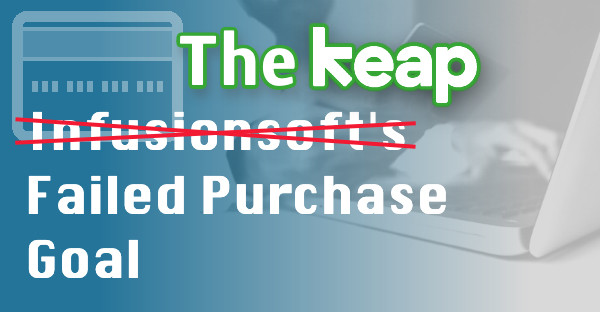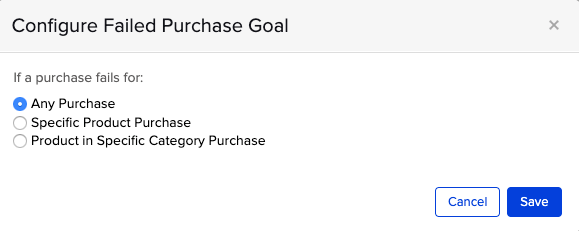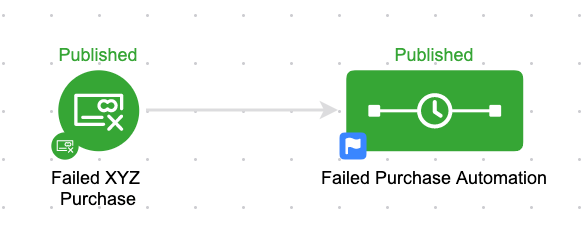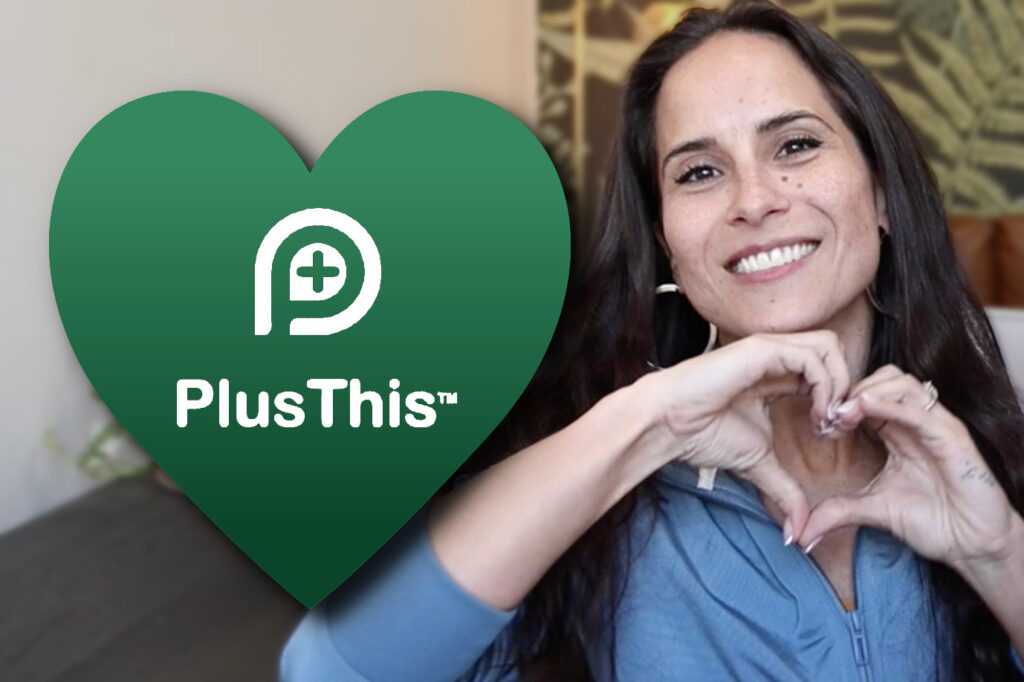Listen up campaign builders – we’ve got a brand new goal method, introducing Keap’s Failed Purchase Goal.
The Failed Purchase Goal
The idea that we can trigger automation when someone attempts to purchase and is unsuccessful isn’t new, but this new goal method allows us a more direct path for starting and stopping automation inside the campaign builder.
The goal has three options for when it will trigger, either on any failure, failure of a specific product, or failure for any product within a category.
The “any purchase” option doesn’t feel as useful to me simply because the automation you trigger wouldn’t be able to be as targeted as with the other two.
As with other campaign goals, once achieved contacts will be added to the sequence following it.
This campaign structure is obviously pretty basic, but it’s what goes inside the Failed Purchase Automation sequence that will need your attention.
If the automation you configure is designed to follow up with the buyer over time, then you’ll also want to make sure this campaign has a conclusion goal so that it automatically stops when they successfully buy.
Check out the video below as I build a sample campaign and address a few of the most common questions I’ve heard on this feature.
Oh, and the section of the video from 10:45-14:00 is no longer necessary. You can skip that sequence/task altogether.
Update: In July 2021 Keap made a change to how failed orders are handled, which simplifies the campaign structure recommended in the video about.
Simply put, failed orders no longer create an open balance. Read about the change here.
FAQS
Is this just for initial purchases?
No.
In my tests I’ve found that this goal method is also achieved when a recurring subscription payment isn’t able to process – another reason to be careful when using the “Any Purchase” option.
Can I use billing merge fields?
No.
If you need to use the credit card or order merge fields then you’ll want to stick with the options in Billing Automation.
(Want the Billing Automation presentation that I accidentally uploaded to my personal YouTube channel?)
This new goal method opens the door for lots of automation opportunities, the trick is to start looking at what is currently happening when someone tries to buy and isn’t able to – and then asking “What should be happening?”
At the very least you might want to add a step that sends them the link to the sales page – but for higher ticket items it might make sense to task a human to reach out and help facilitate the transaction.
If I missed anything here, or you have any questions, please feel free to leave them in the comments below.









[HEADS UP: there’s an IMPORTANT NOTE further below in this comment about something I just learned from Infusionsoft Support]
Greg, thanks for the post on this new “Failed Purchase” goal, especially the info confirming it works with auto-charges on subscriptions.
I was just chatting with Isoft support about another item, and I thought I’d ask if they could confirm this new “Failed Purchase” goal does in fact work with auto-charges on subscriptions (not that I didn’t trust your test results, Greg! Just thought it would be good to know Isoft has documentation on that somewhere).
Isoft support said that, YES, the “Failed Purchase” goal WILL work with auto-charge subscription payments that fail.
BUT they also pointed out something to be aware of that’s a totally different issue. Here it is:
1. You have an existing Contact.
2. That Contact has opted out of receiving emails from you (i.e., Isoft can no longer send them marketing emails).
3. That Contact goes to purchase something from you.
4. That purchase fails.
5. The “Failed Purchase” goal is achieved (because you’ve chosen to use that goal in Campaign Builder).
6. You’ve configured your campaign so that, once the “Failed Purchase” goal is achieved, that triggers a sequence where the Contact is sent an email about the situation…EXCEPT Isoft CANNOT send that email from Campaign Builder because the Contact’s email status won’t allow it.
7. In contrast to that situation, if you did NOT use the “Failed Purchase” goal and a Campaign Builder email, but instead used Billing Automation to detect the failed payment AND to send an email from an template, then that email WOULD be sent.
The bottom line is that while Isoft is not allowed to send emails VIA CAMPAIGN BUILDER to a Contact that has opted out, Isoft CAN still send a ‘failed payment’ email if you do NOT use Campaign Builder to send it.
Which means you have to decide the likelihood that (a) an opted-out Contact will (b) want to buy something from you and (c) that purchase will fail and (d) the Contact will be more likely to try again if they receive an automated email about their failed purchase…if you think the odds of that happening are high enough that you can’t risk NOT sending such a ‘failed payment’ email, then you should NOT use Campaign Builder and this new goal to make that happen…but if you think the odds of that happening are mighty low, then go ahead and use Campaign Builder and this new goal to send that email.
Hope that helps.
Cheers,
Grant
Thanks Grant! And yes, the issue you described is indeed worth considering. For what it’s worth, I (and others) have raised that concern to the product team with hopes of helping encourage a solution – for example, I’ve heard it suggested that sequences after a failed purchase goal should perhaps be considered “transactional”, and not governed by the marketable/non-marketable indicator. This is sort of how the Email Confirmation Widget works in the campaign builder.
Either way, good to be aware of for now, and hopefully Infusionsoft will solve that situation as well.
Nice post – Greg, curious if IS has allowed billing failed email to go out if the contact has unsubscribed?
Hi Toby – so, if the email is sent in the campaign builder (as would be the case if it was triggered by the failed billing goal) then I do NOT believe it would be sent to contacts who have previously unsubscribed.
However, if you use the Purchase Actions (or Billing Automation Triggers) options in the Ecommerce>>Settigs area, my understanding is that those ARE sent to contacts irrespective of their email status (because they’re considered transactional emails).
But of course, I recommend testing on your own to verify!
Ah, perfect, thanks Greg! I didn’t know about the billing automation triggers.